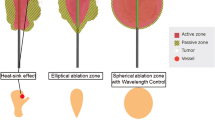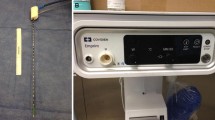Abstract
The aim of this study was to assess the feasibility of the application of the new system (Emprint Microwave Ablation System, Covidien Boulder, CO, USA) and to identify its advantages. In particular the attention was focused to the spherical ablation zone obtained and its usefulness in terms of effectiveness. The new system is composed of: a 2450 MHz generator that delivers a maximum power of 100 W, a fiberglass antenna and a pump for internally cooled antenna. Ten liver nodules (8 hepatocellular carcinomas and 2 metastasis) were percutaneously treated (mean diameter 24.9 mm, range 16–35 mm). Technical success, ablation duration time, overall procedure time and safety were registered. To define the shape of the ablation zone, multiplanar reformatting (MPR) was performed. Roundness index transverse was calculated: a value near 1 represents a more spherical ablation zone shape, and a value distant from 1 implies an oval configuration. Technical success was 100 %. Mean ablation time was of 3.85 min (range 3–5 min), mean overall procedure time was 30.5 min (range 25–40 min). No major complications were recorded. Roundness index transverse presented a mean value of 0.94, meaning that a spherical shape of ablation zone was achieved. One of the most promising innovations of the new microwave technology is the spherical shape of the ablation volume that could be related with an improving of the effectiveness and safety.


Similar content being viewed by others
References
Carrafiello G, Laganà D, Mangini M et al (2008) Microwave tumors ablation: principles, clinical applications and review of preliminary experiences. Int J Surg. 6(Suppl 1):S65–S69
Brace CL (2010) Microwave tissue ablation: biophysics, technology, and applications. Crit Rev Biomed Eng 38(1):65–78
Ahmed M, Brace CL, Lee FT Jr et al (2011) Principles of and advances in percutaneous ablation. Radiology 258(2):351–369
The National Cancer Institute (2010) Common Terminology Criteria for Adverse Events (CTCAE) Version 4.0, Bethesda. Approved after October 1, 2009
Eisenhauer EA, Therasse P, Bogaerts J et al (2009) New response evaluation criteria in solid tumours: revised RECIST guideline (version 1.1). Eur J Cancer 45(2):228–247
Park MJ, Kim YS, Rhim H et al (2011) A comparison of US-guided percutaneous radiofrequency ablation of medium-sized hepatocellular carcinoma with a cluster electrode or a single electrode with a multiple overlapping ablation technique. J Vasc Interv Radiol 22(6):771–779
Knavel EM, Brace CL (2013) Tumor ablation: common modalities and general practices. Tech Vasc Interv Radiol. 16(4):192–200
Brace CL (2009) Microwave ablation technology: what every user should know. Curr Probl Diagn Radiol 38:61–67
Yu J, Liang P, Yu XL et al (2012) US-guided percutaneous microwave ablation of renal cell carcinoma: intermediate-term results. Radiology 263:900–908
Durick NA, Laeseke PF, Broderick LS et al (2008) Microwave ablation with triaxial antennas tuned for lung: results in an in vivo porcine model. Radiology 247:80–87
Tropea A, Biondi A, Corsaro A et al (2014) Combined microwave thermal ablation and liver resection for single step treatment of otherwise unresectable colorectal liver metastases: a monoistitutional experiences. Eur Rev Med Pharmacol Sci 18(2 Suppl):6–10
Tsutsui H, Usuda J, Kubota M et al (2008) Endoscopic tumor ablation for laryngotracheal intraluminal invasion secondary to advanced thyroid cancer. Acta Otolaryngol 128:799–807
Mertyna P, Dewhirst MW, Halpern E et al (2008) Radiofrequency ablation: the effect of distance and baseline temperature on thermal dose required for coagulation. Int J Hyperthermia 24(7):550–555
Lencioni R, Cioni D, Crocetti L et al (2005) Early stage hepatocellular carcinoma in patients with cirrhosis: long-term results of percutaneous image-guided radiofrequency ablation. Radiology 234(3):961–967
Gervais DA, McGovern FJ, Arellano RS et al (2005) Radiofrequency ablation of renal cell carcinoma. Indications, results, and role in patient management over a 6-year period and ablation of 100 tumors. Am J Roentgenol. 185(1):64–71
Ierardi AM, Floridi C, Fontana F et al (2013) Microwave ablation of liver metastasis to overcome the limitations of radiofrequency ablation. Radiol Med. 118(6):948–961
Carrafiello G, Mangini M, Fontana F et al (2012) Complications of microwave and radiofrequency lung ablation: personal experience and review of the literature. Radiol Med. 117(2):201–213
Grosso G, Gruttadauria S, Biondi A, Marventano S, Mistretta A et al (2012) Worldwide epidemiology of liver hydatidosis including the Mediterranean area. World J Gastroenterol 18(13):1425–1437
Pereira PL, Trubenbach J, Schenk M et al (2004) Radiofrequency ablation: in vivo comparison of four commercially available devices in pig livers. Radiology 232:482–490
De Baere T, Denys A, Wood BJ et al (2001) Radiofrequency liver ablation: experimental comparative study of water-cooled versus expandable systems. Am J Roentgenol 176:187–192
Conflict of interest
Authors declare that there are no conflicts of interest regarding the publication of this article.
Ethical standard
All procedures performed in studies involving human participants were in accordance with the ethical standards of the institutional and/or national research committee and with the 1964 Helsinki declaration and its later amendments or comparable ethical standards.
Informed consent
Informed consent was obtained from all individual participants included in the study.
Author information
Authors and Affiliations
Corresponding author
Rights and permissions
About this article
Cite this article
Ierardi, A.M., Mangano, A., Floridi, C. et al. A new system of microwave ablation at 2450 MHz: preliminary experience. Updates Surg 67, 39–45 (2015). https://doi.org/10.1007/s13304-015-0288-1
Received:
Accepted:
Published:
Issue Date:
DOI: https://doi.org/10.1007/s13304-015-0288-1




